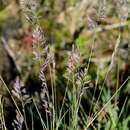Associations
provided by BioImages, the virtual fieldguide, UK
In Great Britain and/or Ireland:
Foodplant / gall
stroma of Epichlo causes gall of stem of Festuca ovina sens.str.
Comments
provided by eFloras
Many infraspecific taxa have been described, in which, Festuca ovina var. duriuscula ((L.) Koch was recorded in Taiwan.
- license
- cc-by-nc-sa-3.0
- copyright
- Missouri Botanical Garden, 4344 Shaw Boulevard, St. Louis, MO, 63110 USA
Comments
provided by eFloras
This is an extremely polymorphic species with a natural distribution throughout temperate and cold parts of the N hemisphere. It provides good forage on poor upland soils. Numerous variants have been recognized at infraspecific rank, often from different habitats and based on small differences in pubescence, size, proportion of vegetative and floral parts, and other characters. The name
Festuca airoides Lamarck, a European segregate, has been applied to plants from the
F. ovina complex in China.
Festuca ovina and related species (nos. 43–47) can be distinguished from members of the F. rubra complex as follows: plants densely tufted, without rhizomes; young leaf sheaths with free, overlapping margins; shoots intravaginal; leaf blades with only midrib or also two lateral ribs well defined; leaf sclerenchyma a continuous or broken subepidermal band, or 3 broad strands at midrib and margins.
- license
- cc-by-nc-sa-3.0
- copyright
- Missouri Botanical Garden, 4344 Shaw Boulevard, St. Louis, MO, 63110 USA
Description
provided by eFloras
Culm 20-30 cm tall, less than 0.5 mm in diameter, base erect, new shoots all intra-vaginal. Blades radical, tufted, coriaceous, needle-like, 0.5 mm indiameter; ligule chartaceous, 0.3 mm long, fimbriate. Panicle narrow. Spikelets several-flowered, up to 9 mm long, more or less compressed; glumes chartaceous; the lower narrowly lanceolate, 1-nerved, 5 mm long; the upper lanceolate, 3--nerved, mucronate, 6 mm long; lemmas subcoriaceous, 6 mm long, boat-shaped, lanceolate, 5-nerved, with a short awn; palea subcoraceous, oblong, 2-keeled, 5.5 mm long. Caryopsis 3.5 mm long, sylindrical; hilum linear.
- license
- cc-by-nc-sa-3.0
- copyright
- Missouri Botanical Garden, 4344 Shaw Boulevard, St. Louis, MO, 63110 USA
Description
provided by eFloras
Plant densely tufted; shoots intravaginal. Culms 10–60 cm tall; node 1. Leaf sheaths glabrous or basal leaf sheaths occasionally with trichomes; auricles present as erect swellings or absent; leaf blades filiform, conduplicate, (3–)8–25 cm × 0.3–0.6 mm, margins usually scabrid, veins 5(–7); adaxial to abaxial sclerenchyma strands absent, abaxial sclerenchyma in a continuous ring; ligule (0.1–)0.2–0.5 mm, margin ciliate. Panicle contracted, narrow, 2–8 cm; branches (0.5–)1–2 cm, 1 at lowest node. Spikelets 4–6 mm, greenish, purplish or brown; florets 3–6; glumes glabrous or scabrid below apex; lower glume narrowly lanceolate to lanceolate, 1.8–2.8 mm; upper glume lanceolate or broadly lanceolate, 2.8–3.5 mm; rachilla internodes 0.8–1 mm; lemmas 3–4(–5) mm, punctiform or scabrid; awns 0.5–2 mm; palea keels scabrid. Anthers 1.5–2.2 mm. Ovary apex glabrous. Fl. and fr. Jun–Sep.
- license
- cc-by-nc-sa-3.0
- copyright
- Missouri Botanical Garden, 4344 Shaw Boulevard, St. Louis, MO, 63110 USA
Distribution
provided by eFloras
Widely distributed in temperate lands throughout the world, and in the alpine of tropical area.
- license
- cc-by-nc-sa-3.0
- copyright
- Missouri Botanical Garden, 4344 Shaw Boulevard, St. Louis, MO, 63110 USA
Distribution
provided by eFloras
Anhui, Gansu, Guizhou, Jiangsu (cultivated), Jilin, Nei Mongol, Ningxia, Qinghai, Shaanxi, Sichuan, Taiwan, Xinjiang, Xizang, Yunnan, Zhejiang [Japan, Korea, Mongolia, Russia; SW Asia (Caucasus), Europe, North America].
- license
- cc-by-nc-sa-3.0
- copyright
- Missouri Botanical Garden, 4344 Shaw Boulevard, St. Louis, MO, 63110 USA
Habitat
provided by eFloras
Alpine meadows, steppe, grassy places in forests; 1600–4400 m.
- license
- cc-by-nc-sa-3.0
- copyright
- Missouri Botanical Garden, 4344 Shaw Boulevard, St. Louis, MO, 63110 USA
Physical Description
provided by USDA PLANTS text
Perennials, Terrestrial, not aquatic, Stems nodes swollen or brittle, Stems erect or ascending, Stems caespitose, tufted, or clustered, Stems or basal sheaths yellow to green, brown or black at base, Stems terete, round in cross section, or polygonal, Stem internodes hollow, Stems with inflorescence less than 1 m tall, Stems, culms, or scapes exceeding basal leaves, Leaves mostly basal, below middle of stem, Leaves mostly cauline, Leaves conspicuously 2-ranked, distichous, Leaves sheathing at base, Leaf sheath mostly open, or loose, Leaf sheath smooth, glabrous, Leaf sheath and blade differentiated, Leaf blades linear, Leaf blades very narrow or filiform, less than 2 mm wide, Leaf b lade margins folded, involute, or conduplicate, Leaf blades mostly glabrous, Ligule present, Ligule an unfringed eciliate membrane, Inflorescence terminal, Inflorescence an open panicle, openly paniculate, branches spreading, Inflorescence a contracted panicle, narrowly paniculate, branches appressed or ascending, Inflorescence solitary, with 1 spike, fascicle, glomerule, head, or cluster per stem or culm, Inflorescence branches more than 10 to numerous, Flowers bisexual, Spikelets pedicellate, Spikelets laterally compressed, Spikelet less than 3 mm wide, Spikelets with 3-7 florets, Spikelets solitary at rachis nodes, Spikelets all alike and fertille, Spikelets bisexual, Spikelets disarticulating above the glumes, glumes persistent, Spikelets disarticulating beneath or between the florets, Rachilla or pedicel glabrous, Glumes present, empty bracts, Glumes 2 clearly present, Glumes distinctly unequal, Glumes shorter than adjacent lemma, Glumes 1 nerved, Glumes 3 nerved, Lemm a similar in texture to glumes, Lemma coriaceous, firmer or thicker in texture than the glumes, Lemma 5-7 nerved, Lemma glabrous, Lemma apex acute or acuminate, Lemma mucronate, very shortly beaked or awned, less than 1-2 mm, Lemma margins thin, lying flat, Lemma straight, Palea present, well developed, Palea about equal to lemma, Palea longer than lemma, Palea 2 nerved or 2 keeled, Stamens 3, Styles 2-fid, deeply 2-branched, Stigmas 2, Fruit - caryopsis, Caryopsis ellipsoid, longitudinally grooved, hilum long-linear.
Festuca ovina: Brief Summary
provided by wikipedia EN
Festuca ovina, sheep's fescue or sheep fescue, is a species of grass. It is sometimes confused with hard fescue (Festuca trachyphylla).
- license
- cc-by-sa-3.0
- copyright
- Wikipedia authors and editors

